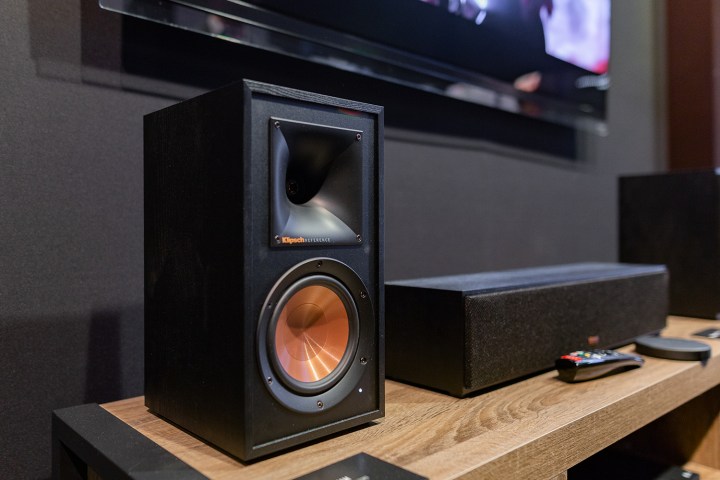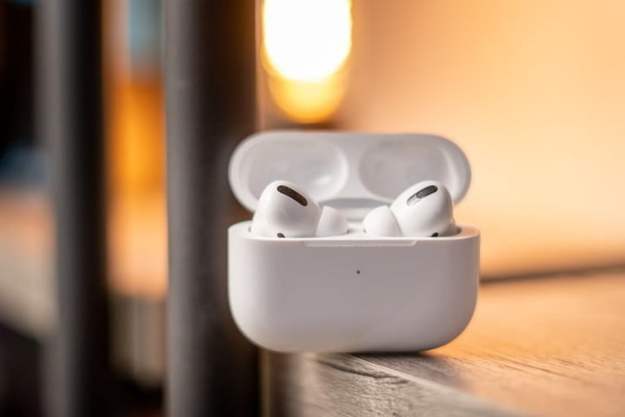
CES 2019 is just getting going and we’ve already seen some very cool home theater innovations, from Samsung’s 219-inch Micro LED monstrosity known as “The Wall,” to LG’s absolutely stunning 88-inch, 8K OLED TV (which is quite possibly the most beautiful TV this journalist has ever seen). But when it comes to tech you can put your hands on, one of the most intriguing new trends to come out of Las Vegas this year comes from a technology that’s not new at all: A wireless audio protocol known simply as WiSA.
In LG’s demo at the Mandalay Bay hotel in Las Vegas, the brand displayed one of its new WiSA-certified TVs sending pure, high-quality surround sound directly to a 5.1-channel powered speaker setup from Klipsch; no wires (or A/V receiver) required. WiSA (which stands for Wireless Speaker and Audio) is a certification standard and technology co-founded by a little-known technology outfit called Summit Wireless which uses a special chipset that allows for crystal-clear, high-resolution audio to be transmitted wirelessly to any supported set of stereo, surround, or even Dolby Atmos speakers from a growing array of audio brands. WiSA not only offers lag-free, high-quality sound, but since it’s brand agnostic, it can be implemented by virtually any audio brand which chooses to.
More from CES 2019
- Klipsch’s new Reference home theater system does hi-fi surround without wires
- Is Hisense’s 100-inch, RGB three-laser TV the ultimate home theater centerpiece?
- LG Display’s latest 8K OLED TV screen is also a Dolby Atmos speaker
The technology has been kicking around for years now; we first reported on it at CES 2013. But because there were few source devices capable of delivering WiSA, and only a small number of speaker companies adopting the tech, it failed to take off. In 2019, that will change.
This week’s announcement from Summit Wireless names multiple new source devices adopting the technology, including LG’s 2019 TVs, multiple PCs, and newer Xbox consoles — and that’s just the beginning. Summit Wireless estimates that as many as 60 million “WiSA-ready platforms” will come to market this year. Even at a fraction of that number, one can see the writing on the wall.
With the aid of an affordable adapter — estimated to cost as little as $100 or less – multiple TVs and gaming consoles will soon be able to transmit lag-free audio to a growing number of wireless speakers from brands like Klipsch, JBL/Harman, Golden Ear, and many more. One way or another, home theater is cutting the wires, and with it, traditional surround sound setups.
Home theater hijacking
Of course, long before this week’s developments, we’ve been witnessing a mass exodus from the complicated configurations and bulky form factors that come part-and-parcel with traditional A/V receiver setups. International electronics shows like CES, IFA, and others are excellent bellwethers for predicting in which direction the A/V wind is blowing and, with each passing year, we’ve seen fewer traditional surround sound and hi-fi systems on the showroom floor as companies have retreated to offsite hotel suites, or increasingly, niche shows like Rocky Mountain Audio Fest.

A large portion of this can be attributed to an increasing variety of high-performance soundbars, of course, which have begun enticing consumers to give up the man-cave paradigm for convenience. Offering not only discrete surround sound, but also 3D-audio solutions like Dolby Atmos and DTS:X, soundbars like Samsung’s HW-N950 and Vizio’s 5.1.4 soundbars provide relatively impressive performance, intuitive operation, a smaller profile, and a lower price point than the massive multi-speaker configurations once synonymous with home theater sound.
WiSA allows sound geeks to have their audio cake and eat it too.
But the cool thing about WiSA tech – especially for the self-proclaimed audiophiles among us – is that it allows sound geeks to have their audio cake and eat it too. Sure, you’ve still got to find an electrical source for your speakers, and equivalent powered speakers will run you more cash than passive speakers, but apart from those hurdles, there may soon be very little downside to dropping the traditional A/V receiver or amplifier setup for golden-eared A/V enthusiasts.
In fact, speakers with self-contained amplification can provide myriad performance benefits even apart from the lack of the need for a centralized A/V hub and tangles of wires. Instead of trying to mix and match receivers/amplifiers with speakers for the best sound, listeners can turn to powered speaker makers to design bespoke internal amplification from the inside out, allowing for cleaner sound that’s custom-made for the speakers. Models like KEF’s LS50 Wireless even take things further, offering real-time digital analyzation and correction of the frequencies coming out of each driver before they even hit your ears, assuring perfectly timed delivery of the sound for ultra-clear performance.

Not to mention the ability to incorporate smart technologies like synced multiroom audio throughout the home, digital assistants like Google Assistant and Alexa, and direct Bluetooth and Wi-Fi streaming to your speakers from your phone, all controlled through basic apps.
Perhaps just as important as its performance benefits, WiSA is designed to be extremely simple and convenient to set up. Simply plug in supported speakers and the system will find them and allow you to easily assign them, while also allowing for control of basic parameters from your source device or even an app.
Assault on all sides
Along with WiSA, there are plenty of other technologies the traditional home theater setup will have to contend with in the coming years. Wireless multiroom audio systems like Sonos’ PlayBar and PlayBase are perhaps the most obvious at present, allowing for one button setup and the connection of multiple speakers on one system through Sonos’ simple software.
On the wired side, new technologies like eARC – a feature that arrives with the new HDMI 2.1 spec now being released – will soon allow for TVs and other source devices to send fully uncompressed audio to supported soundbars and other systems, meaning your TV won’t need to do any surround sound or Atmos decoding from connected source components at all.
Of course, the proliferation of all these new technologies will take time. A/V receivers are also adding the latest technologies, and for some, they’ll always have a place in the home theater landscape. That said, while some may lament the coming changes, for those uninterested in complicated menus, stringing wires across the room, and saving space on the TV console for that hulking hunk of A/V receiver tech, it’s an exciting time to be an audio fan.
Editors' Recommendations
- TVs, soundbars, speakers and more: What we’re expecting in home theater at CES 2024
- First ‘Tuned by THX’ home theater speakers need no A/V receivers — or wires


